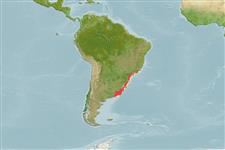Classification / Names
Common names from other countries
Main reference
आकार / वज़न / Age
Max length : 34.4 cm TL पुल्लिंग / अलिंग; (Ref. 111977)
पर्यावरण
; समुद्री
जलवायु / सीमा
Subtropical, preferred 18°C (Ref. 107945); 22°S - 38°S, 60°W - 42°W (Ref. 188)
वितरण
Southwest Atlantic: Rio de Janeiro, Brazil probably to mouth of Rio de la Plata, Argentina (needs confirmation).
देश | ऐफ ऐ ओ क्षेत्र | Ecosystems | संयोग | भूमिका
Short description
पृष्ठीय रीढ़ (सम्पूर्ण): 0; गुदा कांटा 0. Scutes apparent along belly. Upper jaw with distinct median notch. Pectoral fin tip short of pelvic fin base by width of 3 to 7 scales; pelvic fin with oblique and almost straight hind margin. Pre-dorsal scales modified; scales on back and above base of anal fin not markedly smaller than rest. A black spot behind gill opening, but none along flank.
IUCN Red List Status (Ref. 115185)
Threat to humans
Harmless
Human uses
मात्स्यिकी: व्यापारिक
अधिक जानकारी
आम नामउपशब्दचपायचयपरभक्षीईकोटोकसीकोलौजीपुनरुत्पत्तिपरिपक्व अवधिमछलीऔ का अंडे देनाFecundityअंडेEgg development
संदर्भजलीयकृषिजलीयकृषि रूपरेखाखींचआनुवंशिकीऐल्लि आवृतियाँहैरेटिबिलटीबीमारीप्रक्रमणMass conversion
सहयोगीयोतस्वीरेStamps, Coinsध्वनिसिगुयटिरारफ्तारतैरने के प्रकारगिल क्षेत्रOtolithsदिमागदृष्टि
साधन
Special reports
Download XML
इंटरनेट स्रोत
Estimates of some properties based on models
Phylogenetic diversity index
PD50 = 0.5156 many relatives (e.g. carps) 0.5 - 2.0 few relatives (e.g. lungfishes)
Trophic Level
2.8 ±0.31 se; Based on food items.
लौटाव
ऊंचा, न्यूनतम जनसंख्या दुगनी समय अवलागत 15 महीने। (Assuming tm=1)
Vulnerability
Low to moderate vulnerability (26 of 100)
Price category
